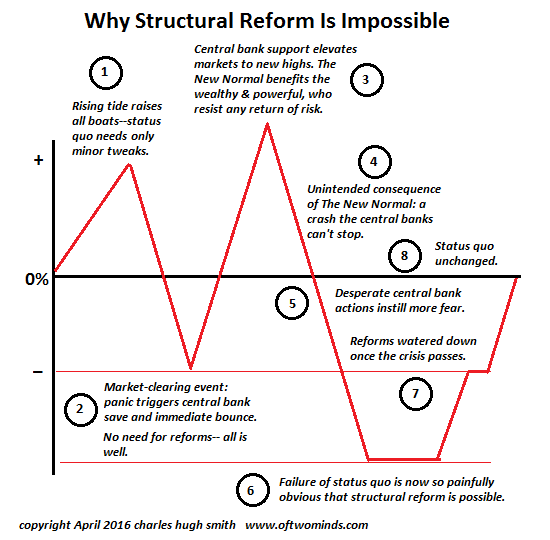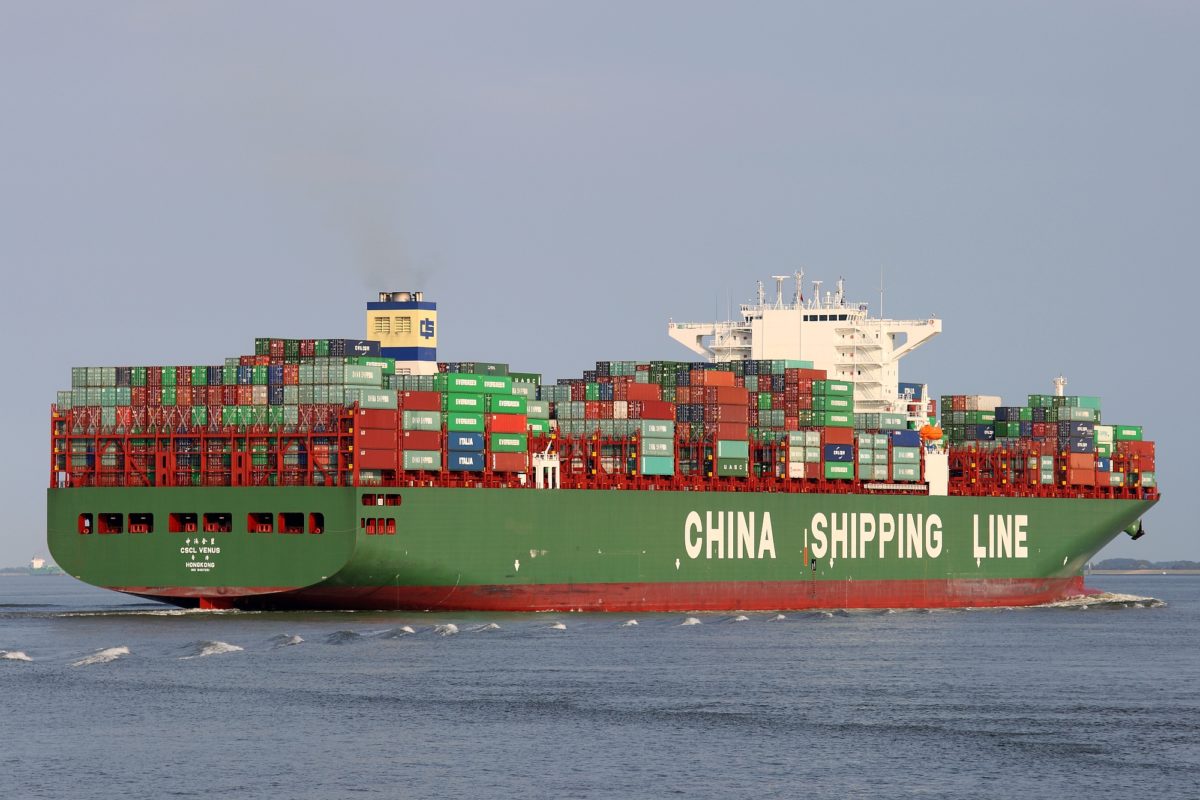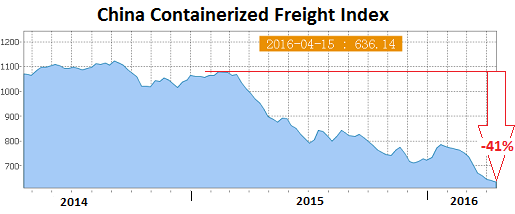Limits to Growth: A report published by the UK government’s new All-Party Parliamentary Group (AAPG) on Limits to Growth reviews the scientific merits of a controversial 1972 model by a team of MIT scientists, which forecasted a possible collapse of civilization due to resource depletion. The recent report found that world fossil fuel production is likely to peak in around 2025… largely as a result of Chinese coal production peaking. An important and often misunderstood issue clarified by the report is that the risk of collapse is not because resources are running out, but because the quality of the available resources is declining while the cost of extracting this lower-quality resource is increasing. According to the report’s authors, growth could well be coming to an end, permanently. (4/22)
The world’s biggest oil companies, set to report their worst quarterly earnings in more than a decade, are finding their cost-cutting efforts haven’t matched the decline in crude prices over the past two years. While producers have been deferring projects, eliminating jobs and freezing salaries, the process will take three years to complete. In the meantime, profits are being hammered. (4/23)
Oil tankers carrying around 200 million barrels of crude are waiting to leave or dock at ports around the world, creating “the world’s biggest traffic jam,” according to a Reuters story. Middle East ports are choking on the oil waiting to be loaded onto tankers and shipped to Asia, and Asian ports are forcing tankers to wait for weeks before unloading because their infrastructure can’t cope with these amounts of oil. (4/18)
Diesel glut: Europe has become a dumping ground for diesel. The continent may run out of onshore capacity and European-bound ships may become offshore storage tankers. (4/20)
In the UK, the so-called Gatwick Gusher shale basin could add as much as $74 billion to the nation’s economy, according to a study by Ernst & Young and commissioned by U.K. Oil & Gas Investments. (4/19)
Russia beat Saudi Arabia as China’s top crude oil supplier in March, a follow-on to taking the No.1 spot in four months of 2015. Shipments from Russia rose 58 percent last month from a year ago to 1.09 million b/d. This compared with February volumes from Russia at 1.03 million b/d and an all-time high at 1.13 million b/d in December. (4/21)
Head-fake “freeze meeting #2”? Major OPEC and other crude producers will meet in Russia, possibly next month, in a new push to agree on an output freeze to shore up oil prices, Iraq’s DeputyOil Minister Fayyad Al-Nima said. There is still no agreement on an oil meeting in May, Russian Energy Minister Alexander Novak said after Al-Nima’s comment. (4/21)
Leviathan a headache: Though a game-changing gas discovery for Israel and for the discoverer, Texas-based Noble Energy, the giant Leviathan offshore gas field in the Eastern Mediterranean has been one bureaucratic headache after another. Now reports are surfacing that the company is seeking to reduce exposure by selling 15 percent of its 40 percent interest in the project. Noble Energy discovered the Leviathan deposit back in 2010. (4/21)
India’s crude oil imports resumed climbing in the year ended March, after stagnating in the previous period, as a new refinery on the country’s east coast started up. The nation’s crude imports rose 6.7 percent to 202.15 million metric tons (about 4.05 million b/d) last financial year. (4/21)
Egypt offers a bright spot for natural gas development, a lone bright spot in an energy world undergoing harsh austerity. Egypt has suffered blackouts due to shortages in natural gas and has been scrambling to make up for the shortfall. But a more enduring solution could soon arrive as Italian oilgiant Eni develops the gigantic Zohr natural gas discovery in the Mediterranean Sea. The field could hold 30 trillion cubic feet of natural gas, enough to make it the largest gas discovery ever recorded in the Mediterranean. (4/22)
East Africa decision: The oil pipeline route puzzle has been solved, with Uganda choosing to export her crude oil to the East African coast through Tanzania and not Kenya. A report states that the Kabaale-Tanga route through Tanzania is the only option to secure first oil exports by mid-2020. (4/21)
Nigeria deployed police and soldiers to gasoline stations to maintain order as fuel shortages grip Africa’s biggest oil producer. The most severe fuel scarcity in a year in Africa’s most populous nation has left motorists paying more than double the government’s official price for gasoline and put increasing pressure on a stagnating economy that’s been hit by tumbling oil prices. (4/22)
The Brazilian pre-salt bonanza has now officially begun, with Norway’s Statoil and partners announcing production of the first oil and gas from the offshore Gavea field in Brazil—part of the largest-ever oil and gas discovery in the Campos Basin’s pre-salt layer. Pre-salt oil and gas deposits are attractive because wells in this layer tend to yield more crude oil than other offshore wells. However, they are also much deeper than other wells, so pre-salt projects tend to be cost-intensive and challenging—particularly in a depressedoil price environment. (4/22)
Offshore Brazil, energy company Statoil and partners Repsol Sinopec Brasil and Petrobras have struck oil in the deepwater Campos Basin. The appraisal well produced around 16 million standard cubic feet of gas and 4,000 barrels per day of oil. (4/19)
Mexican officials are setting out to assure investors of government support for state oil company Pemex after the firm received a $4.2 billion financial lifeline to help it through a cash-flow squeeze brought on by falling oil prices. (4/19)
The total US rig count declined by eight last week to 433, according to Baker Hughes. The number of gas rigs fell by one to 88 while the oil rig count declined by seven to 344.
Total US energy production increased for the sixth consecutive year. According to EIA data, energy production reached a record 89 quadrillion British thermal units, equivalent to 91 percent of total U.S. energy consumption. Liquid fuels production drove the increase, with an 8 percent increase for crudeoiland a 9 percent increase for natural gas plant liquids. Natural gas production also increased 5 percent. These gains more than offset a 10 percent decline in coal production.
Increased US oil production from the Gulf of Mexico is not enough to offset on-shore declines of 1.65 million b/d by 2017. Total U.S. crude oil production is projected to fall 15 percent from 9.43 million b/d in 2015 to 8.04 million b/d in 2017. (4/21)
LNG exports: A tanker from Louisiana loaded with US liquefied natural gas is en route to Portugal, the first shipment in a trade relationship that could shake up the European market. The 970-foot long Creole Spirit is expected to arrive by the end of April. In Europe, American gas will add to a swell in supply in a crowded market long dominated by Russia. Analysts predict that the arrival of U.S. gas could trigger a price war, leading to lower prices for consumers that could act as a shot in the arm for the struggling European economy. (4/22)
Alaska has long been a bastion of US oil production, even giving dividend checks to residents from oil revenues. But oil price woes are having a major effect on a state that has no state income tax or state sales tax, and crude production on Alaska’s North Slope in 2015 fell to its lowest point in decades. (4/18)
The global oil-market rout is weighing on General Electric, which posted a quarterly decline in operating income and orders for its core industrial businesses. GE reported a 6.1 percent gain in revenue for the first three months of 2016, but profit declines in units making locomotives, power turbines and oil-industry equipment hurt its bottom line. (4/23)
Oil companies seeking cash have found a well that keeps producing: the stock market. Callon Petroleum Co., a small oil producer, has sold new shares three times in the past six months to raise cash, most recently in a successful sale Tuesday night. Though stock prices often decline on such deals due to the addition of new shares, Callon’s shares ended Wednesday up 12 percent, at $10, as the price of oil reached near a five-month high and US energy shares broadly rallied on better-than-expected crude-supply data. (4/21)
Rig company Transocean said it was delaying the delivery of two ultra-deepwater drill ships to 2020 in an agreement with a shipyard company in Singapore. (4/21)
Oil-to-solar jobs: A few years ago, Sean and Stormy Fravel were riding the oiland gas boom like so many others in West Texas. But when their jobs disappeared along with $100-a-barrel oil prices, they turned to a new type of energy occupation: solar power. Instead of driving an 18-wheeler to haul drilling equipment in and out of the oil patch, the Fravels now install solar panel racking systems and perform quality checks on a solar farm under construction in McCamey, about 300 miles northwest of San Antonio. (4/22)
State-level taxes and fees on gasoline in the United States averaged 26.5 cents per gallon (¢/gal) as of January 1, 2016. These taxes and fees ranged from a low of 8.95¢/gal in Alaska to a high of 51.4¢/gal in Pennsylvania, in addition to the federal tax of 18.4¢/gal. (4/20)
US energy bill: As recently as a week ago, the energy bill that Congress was considering was stalled and faced an uphill battle. But the Senate has sprung into action, and voted in favor it by 85-12. The energy package is the first major piece of energy legislation passed in almost a decade. At the same time, it is a rather modest piece of action. (4/21)
Developing “clean coal” technology would help the coal sector in both the US and China and prevent further job losses, the US energy secretary has said. Crashing prices for coal amid China’s economic slowdown and US investors’ preference for newer, less polluting energy technology has hit the industry hard in both countries. (4/19)
Climate: Representatives from more than 150 countries gathered at the UN last Friday to sign a global accord aimed at slashing greenhouse gas emissions and slowing climate change. But in the four months, since that historic pact was negotiated in Paris, a drumbeat of grim scientific findings has underscored that staving off the worst consequences of global warming may take far more aggressive actions. The first three months of 2016 were the warmest on record in 136 years — by large margins. (4/21)
Sea levels could rise by much more than originally anticipated, and much faster, according to new data being collected by scientists studying the melting West Antarctic ice sheet – a massive sheet the size of Mexico. That revelation was made by an official with the National Oceanic and Atmospheric Administration on Tuesday at the annual RIMS conference for risk management and insurance professionals in San Diego, CA. (4/22)









